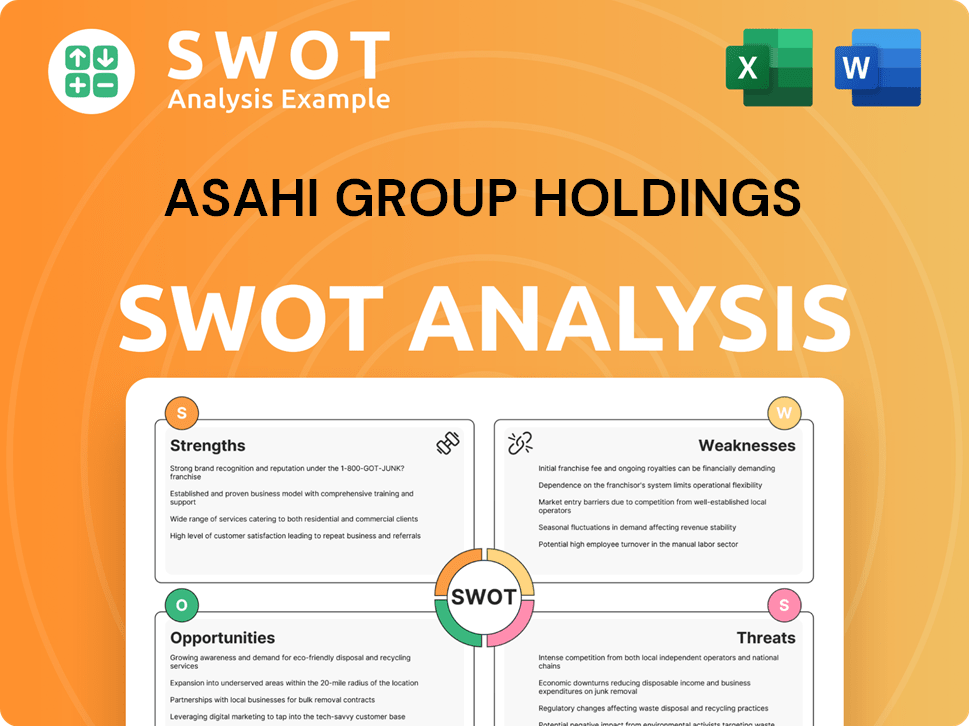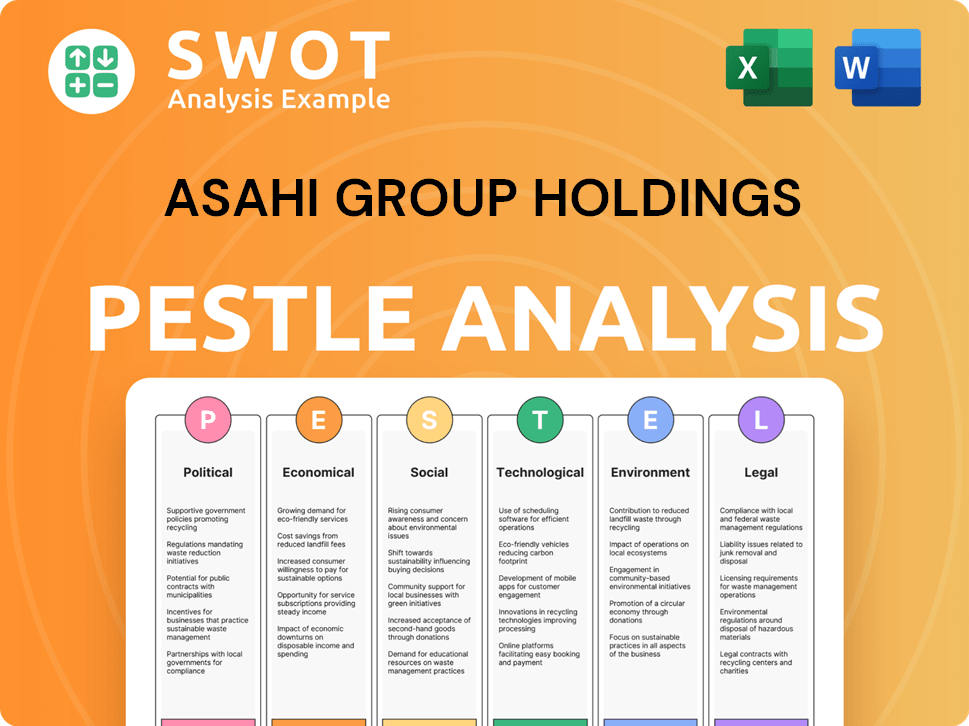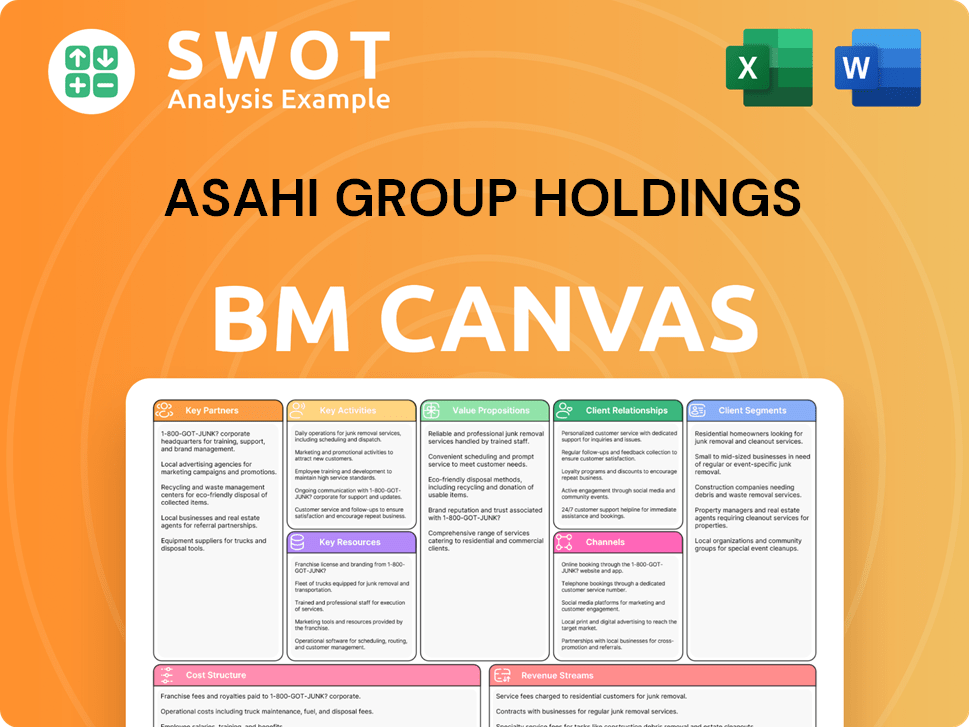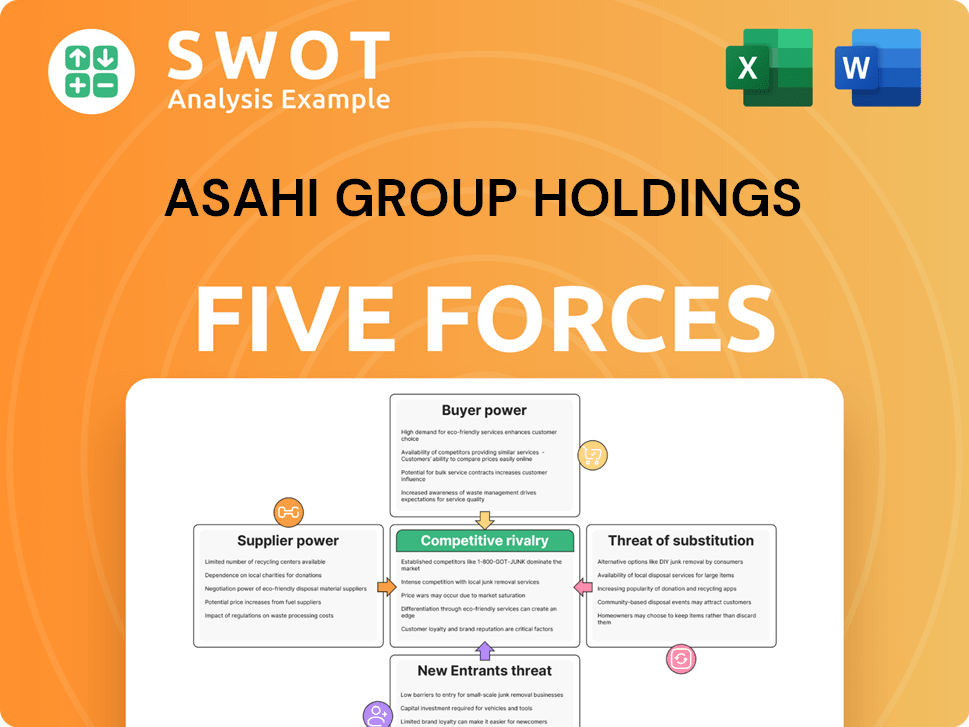Asahi Group Holdings Bundle
How did Asahi Group Holdings go from a local brewery to a global giant?
Journey back in time to uncover the fascinating Asahi Group Holdings SWOT Analysis and its remarkable transformation. From its humble beginnings in 1889 as the Osaka Beer Company, this Japanese beer company has continually innovated and expanded its reach. Discover the pivotal moments, including the game-changing introduction of Asahi Super Dry in 1987, that shaped its success.

This exploration unveils the Asahi beer history, tracing its evolution within the Japanese beverage industry and beyond. Learn about the key milestones in the company timeline, its strategic acquisitions, and its impact on the global beer market. Understanding the brief history of Asahi Super Dry and the company's global expansion offers valuable insights into its enduring appeal and financial performance.
What is the Asahi Group Holdings Founding Story?
The story of Asahi Group Holdings begins with the Osaka Beer Company, established on May 17, 1889. This marked the inception of a Japanese beer company that would evolve into a global beverage giant. The founders, a group of Osaka businessmen, saw an opportunity in the burgeoning demand for Western-style beer in Japan, aiming to provide a quality domestic alternative.
Their goal was to compete with established foreign brands by focusing on superior ingredients and brewing methods. The initial business model centered on brewing and selling beer directly to consumers and distributors in the Kansai region. The first product was 'Asahi Beer,' a name that translates to 'morning sun,' symbolizing a fresh start and quality. The venture was backed by local capital from the founding businessmen.
The late 19th century in Japan, with its rapid modernization and openness to Western influences, set the stage for the company's creation. Beer consumption was gaining popularity among the populace, creating a favorable market environment for the Osaka Beer Company.
The Osaka Beer Company, the precursor to Asahi Group Holdings, was founded in 1889. It was established by Osaka businessmen to produce a high-quality domestic beer.
- The company's initial product was 'Asahi Beer.'
- The founders aimed to compete with established foreign beer brands.
- The company's creation was influenced by rapid modernization and Western influence in Japan.
- Initial funding came from the founding businessmen.
For more details on the company's operations, you can explore Revenue Streams & Business Model of Asahi Group Holdings.
Asahi Group Holdings SWOT Analysis
- Complete SWOT Breakdown
- Fully Customizable
- Editable in Excel & Word
- Professional Formatting
- Investor-Ready Format

What Drove the Early Growth of Asahi Group Holdings?
The early growth of the Osaka Beer Company, the precursor to Asahi Group Holdings, focused on establishing a strong presence in the Japanese market. The quality of its 'Asahi Beer' quickly gained recognition, and the company began to expand its production and distribution. Significant developments in the early 20th century included mergers that consolidated the Japanese brewing industry, setting the stage for greater market share.
In its initial phase, the Japanese beer company concentrated on building a solid base in Japan. The primary focus was on the quality of its product, which helped it gain recognition. This early strategy was key to its initial success and set the stage for future expansion.
The early 20th century saw mergers that reshaped the Japanese brewing landscape. These consolidations positioned the company for increased market share. The expansion of production and distribution networks across Japan was a key strategic move.
After World War II, the company was divided, leading to the formation of Asahi Breweries, Ltd. This marked a new era of independent growth. The company began to diversify its product offerings beyond traditional lagers.
A pivotal moment was the 1987 launch of Asahi Super Dry, which transformed the Japanese beer market. This success led to significant investment in production and expansion. The company also started exploring international markets.
The company's history includes significant milestones, such as the launch of Asahi Super Dry in 1987, which revolutionized the Japanese beer market. This innovation fueled the company's growth, leading to increased investment in production facilities and expansion into international markets. For a deeper understanding of how the company has evolved its marketing strategies, you can explore the Marketing Strategy of Asahi Group Holdings.
Asahi Group Holdings PESTLE Analysis
- Covers All 6 PESTLE Categories
- No Research Needed – Save Hours of Work
- Built by Experts, Trusted by Consultants
- Instant Download, Ready to Use
- 100% Editable, Fully Customizable

What are the key Milestones in Asahi Group Holdings history?
The Growth Strategy of Asahi Group Holdings has been marked by significant milestones, from its inception to its current global presence. The company's journey includes key product launches, strategic partnerships, and expansions into new markets, shaping its evolution within the Japanese beverage industry and beyond.
| Year | Milestone |
|---|---|
| 1889 | Asahi Breweries is established in Japan. |
| 1987 | Launch of Asahi Super Dry, revolutionizing the beer market with its 'karakuchi' flavor. |
| 2009 | Acquisition of Schweppes, expanding the non-alcoholic beverage portfolio. |
| 2016 | Acquisition of SABMiller's European beer brands, including Peroni and Grolsch, significantly boosting its international presence. |
| 2019 | Acquisition of Carlton & United Breweries in Australia, further solidifying its global position. |
Innovation has been a cornerstone of Asahi Group Holdings' success, particularly with the introduction of Asahi Super Dry, which created a new category in the beer market. The company has consistently sought to improve its brewing processes and packaging, securing patents to maintain a competitive edge.
The launch of Asahi Super Dry in 1987 marked a pivotal moment, establishing the 'karakuchi' (dry) beer style. This innovation quickly gained popularity, reshaping consumer preferences and driving market share gains for the Japanese beer company.
Asahi has consistently invested in research and development, securing patents related to its brewing processes. These innovations have helped maintain the unique taste profile of its products and improved production efficiency.
The company has also focused on packaging innovations to enhance product appeal and shelf life. This includes advancements in can and bottle designs, as well as sustainable packaging solutions.
Asahi has expanded its product offerings to cater to diverse consumer tastes, introducing new variations and flavors of its core brands. This strategy helps to maintain customer interest and capture a broader market segment.
Asahi has increased its investment in digital marketing to reach consumers. This includes social media campaigns, online advertising, and e-commerce initiatives to boost brand visibility and sales.
Asahi has introduced sustainability initiatives, including eco-friendly packaging and reducing carbon emissions. These efforts reflect the company's commitment to environmental responsibility and appeal to eco-conscious consumers.
Asahi Group Holdings has faced challenges such as market downturns and intense competition, particularly in the Japanese beer market. Declining beer consumption in Japan has prompted the company to diversify its portfolio and expand internationally.
Intense competition from both domestic and international rivals has been a constant challenge. Asahi has responded by focusing on brand differentiation and strategic acquisitions to maintain its market position.
Shifts in consumer preferences, including a decline in beer consumption in Japan, have required the company to diversify its product offerings. This includes investments in non-alcoholic beverages and international brands.
Economic downturns and fluctuations in currency exchange rates have impacted Asahi's financial performance. The company has implemented cost-saving measures and adjusted its pricing strategies to mitigate these effects.
Integrating acquired brands and businesses into the Asahi Group has presented operational challenges. The company has focused on streamlining operations and leveraging synergies to improve efficiency.
Disruptions in the global supply chain, including raw material shortages and logistics challenges, have affected production and distribution. Asahi has worked to diversify its supply sources and improve its supply chain resilience.
Changes in regulations, such as those related to alcohol advertising and labeling, require Asahi to adapt its marketing strategies. The company has maintained compliance with relevant laws and regulations.
Asahi Group Holdings Business Model Canvas
- Complete 9-Block Business Model Canvas
- Effortlessly Communicate Your Business Strategy
- Investor-Ready BMC Format
- 100% Editable and Customizable
- Clear and Structured Layout

What is the Timeline of Key Events for Asahi Group Holdings?
The Asahi Group Holdings has a rich Asahi beer history, starting in 1889 with the founding of the Osaka Beer Company. Over the years, it has grown from a local brewery to a global beverage giant. This Japanese beer company has consistently adapted to market changes, expanding its product range and geographic presence. The company's strategic acquisitions and innovative product launches have helped it maintain a competitive edge in the dynamic Japanese beverage industry.
| Year | Key Event |
|---|---|
| 1889 | The Osaka Beer Company was founded, marking the beginning of the company's journey. |
| 1906 | The company merged to form Dai Nippon Breweries, expanding its production capacity. |
| 1949 | Re-establishment occurred as Asahi Breweries, Ltd., after World War II. |
| 1958 | Asahi Breweries introduced the first canned beer in Japan, a significant innovation. |
| 1987 | The launch of Asahi Super Dry revolutionized the Japanese beer market, becoming a flagship product. |
| 1990 | The company was renamed Asahi Group Holdings, Ltd., reflecting its diversification. |
| 2011 | Acquisition of Schweppes Australia expanded its non-alcoholic beverage portfolio. |
| 2016 | Acquired Peroni Nastro Azzurro, Grolsch, and Meantime brands from Anheuser-Busch InBev, expanding its international presence. |
| 2017 | Acquired Fuller's Griffin Brewery and its beer business, strengthening its position in the UK market. |
| 2020 | Acquisition of Carlton & United Breweries (CUB) and other associated brands in Australia from Anheuser-Busch InBev. |
Asahi Group Holdings is focusing on international expansion, especially in Europe and Oceania. This includes strategic acquisitions and organic growth. Recent financial reports show increased revenue from international markets, indicating successful expansion efforts. The company aims to increase its market share in key regions, with a focus on premium brands. The company’s global strategy is designed to mitigate the impact of declining domestic beer consumption.
Asahi is investing in sustainable practices across its supply chain, aiming for significant reductions in CO2 emissions and water usage by 2030. This commitment aligns with broader industry trends towards environmental responsibility. The company is implementing eco-friendly packaging and reducing waste. Sustainability efforts are becoming increasingly important for consumers, impacting brand perception and loyalty. By focusing on sustainability, Asahi aims to meet evolving consumer expectations.
The company is focusing on premium brands to drive revenue growth. This strategy involves marketing high-quality products and expanding the premium product portfolio. The company is investing in premium beer segments, which offer higher profit margins. This strategy aims to cater to consumers seeking premium experiences. The company is also leveraging its strong brand portfolio to enhance its market position.
Asahi Group Holdings is committed to leveraging technological advancements for brewing innovation and supply chain efficiency. This includes incorporating advanced brewing techniques to improve product quality. The company is investing in data analytics to optimize its supply chain and reduce costs. Technological advancements are crucial for maintaining a competitive edge. This focus on technology supports the company’s long-term growth objectives.
Asahi Group Holdings Porter's Five Forces Analysis
- Covers All 5 Competitive Forces in Detail
- Structured for Consultants, Students, and Founders
- 100% Editable in Microsoft Word & Excel
- Instant Digital Download – Use Immediately
- Compatible with Mac & PC – Fully Unlocked

Related Blogs
- What is Competitive Landscape of Asahi Group Holdings Company?
- What is Growth Strategy and Future Prospects of Asahi Group Holdings Company?
- How Does Asahi Group Holdings Company Work?
- What is Sales and Marketing Strategy of Asahi Group Holdings Company?
- What is Brief History of Asahi Group Holdings Company?
- Who Owns Asahi Group Holdings Company?
- What is Customer Demographics and Target Market of Asahi Group Holdings Company?
Disclaimer
All information, articles, and product details provided on this website are for general informational and educational purposes only. We do not claim any ownership over, nor do we intend to infringe upon, any trademarks, copyrights, logos, brand names, or other intellectual property mentioned or depicted on this site. Such intellectual property remains the property of its respective owners, and any references here are made solely for identification or informational purposes, without implying any affiliation, endorsement, or partnership.
We make no representations or warranties, express or implied, regarding the accuracy, completeness, or suitability of any content or products presented. Nothing on this website should be construed as legal, tax, investment, financial, medical, or other professional advice. In addition, no part of this site—including articles or product references—constitutes a solicitation, recommendation, endorsement, advertisement, or offer to buy or sell any securities, franchises, or other financial instruments, particularly in jurisdictions where such activity would be unlawful.
All content is of a general nature and may not address the specific circumstances of any individual or entity. It is not a substitute for professional advice or services. Any actions you take based on the information provided here are strictly at your own risk. You accept full responsibility for any decisions or outcomes arising from your use of this website and agree to release us from any liability in connection with your use of, or reliance upon, the content or products found herein.